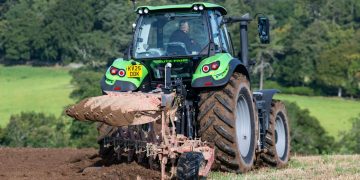FURIOUS locals at a UK beauty spot have had their views wrecked by a line of battered and rotting caravans.
A landowner in Stonehouse, Gloucestershire, has plonked the “wall” of dilapidated vehicles along a stretch of a popular public footpath.

A landowner has blocked access to a beauty spot with a ‘wall’ of dilapidated caravans[/caption]

Residents had previously been able to walk freely across the Verney Fields in Stonehouse[/caption]

Madeline Lindley’s moveable fence between her garden and the field was nailed shut[/caption]
The farmer claims he was forced to take the unusual step in order to stop “vandalism” on his property.
But fed-up residents say the blockade is “an eyesore” and want him to remove them immediately.
The land on the edge of the popular town has been a bone of contention between the town and the site’s owners for several years.
Residents had previously been able to walk freely across the Verney Fields – part of a farm known as Spring Valley Orchard Farm – for centuries.
As the town’s largest open, green space, the spot has been a popular recreational attraction since the early 1800s.
But now the current owners, who have renamed it Windmill Farm, are blocking locals from using the land by putting rows of beaten-up, rotting caravans along the public access path.
The caravans are effectively being used as fencing, locals say.
Furious Mike Giles, 67, lives close to the spot and told the Sun: “This land has been a part of the community for so long.
“People really love the space and it is a shame they think they can take advantage by taking it from us.
“There has been so much torment with just trying to keep the public footpaths there which have been around for ages.
“There is so much history in that place – it is a shame to see it come so unkept and shut off. There are even listed trees on the land.
“It is a very important area and it’s being turned into an eyesore.”
Locals have even set up an action group, called Verney Lane Friends, to help fight the owners’ blockade.
Member Rachel Armstrong said it is “a terrible shame” the landowners are “wrecking people’s ability to enjoy the space”.

Rows of beaten-up, rotting caravans have been put along the public access path[/caption]

Furious Mike Giles, 67, lives close to the spot[/caption]

The caravans are effectively being used as fencing, locals say[/caption]
She said: “It was a real hub during covid for people to enjoy an outdoor space. It has become so important to everyone.
“People have walked their dogs down there for years every day but now it just feels unsafe to walk down.
“It is unstable ground now and you don’t know where you can tread.”
Locals say Verneys Field has historically never become overgrown but since the caravans were put in place the grass has not been cut and it is now almost impossible to walk through – even if they can get through the caravan “fence”.
Ms Armstrong said: “Before the land was bought by the current owners it was always well-looked after.
“The grass was always cut and the public footpath conserved. Now the area is almost impossible to walk through.”
Madeleine Lindley, 74, has lived with her garden backing onto the land for 24 years.
During her time in Verney Road she has made sure to keep the area of long grass from the field cut as a safety procedure incase of a fire.
People really love the space and it is a shame they think they can take advantage by taking it from us.
Mike Giles
She also enjoyed making flower borders for the whole neighbourhood to marvel at and planted Christmas trees for local children in the street to decorate each year.
But she says that last Christmas the tree was cut down by the current owners and a moveable fence her son put up between her garden and the field was nailed shut.
She said: “My son made that fence for me. There was never a problem until they moved in.
“I was shocked about the fence when I saw it nailed shut. I had to get my neighbours to help remove the nails.
“Everyone loved the tree too. It was cut down and still fully decorated by the children on the street.
“I even had a letter come to my house telling me I could either buy the little bit of land that the flower bed and mowed grass was on or I had to stop touching it. I couldn’t believe it.”
There appear to have been many disputes between the owners and nearby residents for more than a year and the quarrel has now spread onto social media.
Tempers are running so high that the local council – Stonehouse Town Council – has submitted an application for town and village green status for the site which has three public rights of way across it.
Tree preservation orders for the site were granted by district councillors in November last year.
But locals complain these moves do nothing to address the “eyesore” of battered old caravans – one even has a pair of rotting old trousers inside – spoiling their views across the fields which lie within the Cotswold National Landscape.
What are your rights over a fence row?

IT'S very important to know your rights if you are embroiled in a fence row with a neighbour.
How do I know which side I own?
A boundary feature can be a fence, wall, hedge, ditch, piece of wire, or sometimes even just the edge of a driveway.
The only way to know for certain who owns what side and to avoid any neighbour disputes, is to refer to the title plan or Land Registry.
In this, the T mark is used to indicate who the boundary belongs to and therefore who is responsible for its upkeep, say pros at Jacksons Fencing.
Larger developments tend to have some indication provided by the builder, but there are no hard and fast rules
People often think they are responsible for the left (or right) hand boundary wherever they live, but there isn’t any legal basis for this.
You can check with HM Land Registry to see which boundary feature you are responsible for.
Often households can’t get hold of the paperwork but experts say they shouldn’t panic.
Homeowners can guess who owns the fence by checking where the rails are.
Pros say: “The fence is typically facing away from their property so that their neighbour gets the ‘good’ side.
“This is the most secure way of facing fencing so there are no rails for anyone to use to climb into your garden.
“This is then repeated with the neighbour on the other side to ensure that each home has both a ‘good’ and ‘bad’ fence side.”
Walls and fences are often built on the land of the boundary’s owner with the edge of the wall marking the limit.
While professionals agree a glimpse at the fence can give you a hint, it’s not foolproof – so you can’t be certain.
Fines and punishment
It is recommended to always check legal documents before making changes to avoid hefty fines.
There is no law that the neighbour has to get the good side of the fence, so it’s completely up to whoever owns the fence.
Fencing pros have suggested: “It may be worth selecting a double-sided panel with no ‘bad’ side as both sides look the same and rails are concealed within the fence panel.”
If one boundary backs onto a road or footpath you can install the panels with the rails on the inside
But if it’s installed on the outside, it can provide an “easy ladder for burglars to enter your garden”.
The Royal Institution of Chartered Surveyors (RICS) and the Property Litigation Association have created a mediation service to help neighbours resolve disputes over their property boundaries without resorting to court action.
RICS also provides a list of surveyors who could assist in boundary disputes.
If a dispute continues, it is ultimately a court that makes decisions, but they do not like such disputes being put before them.
Changing a boundary
If you want to change an existing boundary, such as replacing an old fence with a new one, we always recommend discussing with your neighbour first and making sure it is all agreed.
The registered titles can help you to reach an agreement, but only if this information has been added.
In terms of decorations on a fence legal advisers recommended asking around over who actually first installed it.
But they also urged caution before getting to work on amending the fence without getting more certainty yourself – since there is a danger of actually being prosecuted for criminal damage.
How high can a garden fence be?
The height of the fence is measured from your ground level, this can have an impact when, due to slopes in the ground, your garden may be at a higher level than your neighbours‘.
A garden fence can be as high as 100m but you need to get planning permission if it’s over than 2m.
However, there are some complications to this.
If you are thinking about front garden fences, restrictions state that fences alongside a driveway can be a maximum of 1m or 3ft.
You would need to get planning permission for putting a trellis on a fence of 2m.
But, if any plant that you grow on that trellis exceeds 2m, you do not need to obtain a permit for the growing plant.
Verney Fields’ owners say they have placed the caravans there because they have had to spend 200 hours repairing fences cut by vandals across the site.
A spokesperson for Windmill Farm, who manage the site, said the land is private and is being used for agriculture.
They say the caravans may seem like unusual fencing material but they need something that “couldn’t be easily cut through”.
“Sadly we have spent over 200 hours repairing cut through fences and vandalism since last autumn – time which has been taken away from other farming activities and cost us a great deal of loss,” they added.
The owners say the current town and village green application would impose restrictions on apple tree planting if it were successful.
“If some members of the public are causing a disruption to agriculture, it is a farmer’s right to take measures to enable themselves to farm their land; the public are not entitled to any ‘amenity’ or any part of our private farmland.”

Rachel Armstrong said it is ‘a terrible shame’[/caption]

The current owners are blocking locals from using the land[/caption]
Gloucester-based property consultants Bruton Knowles, who act for the owners of the farm, have written to Stonehouse Council to inform them the owners intend to contest the authority’s application to classify the land as an “asset of community value“.
A spokesperson for Bruton Knowles said: “Should an application for local green space be pursued, my client will consider widening the legal advice to include dealing with the designation.
“In addition, consideration will be given to fencing the land to ensure any unconsented access to the land – beyond the footpaths – is stopped.
“I am sure you would agree this would be an unfortunate position for the residents but you will appreciate my client has no option but to protect any interest in the land.
“However…my client would consider gifting a part of the land to the town council in order that residents could use the land as they see fit.
In return my client would like to discuss an allocation for the development of a small number of residential properties – to the west of the site accessed off Bramble Lane – within the neighbourhood plan.
“Should this be of interest, we would be willing to meet to discuss the possibility in greater detail. Clearly any meeting should only proceed if there is a will within the town Council to negotiate on the matter for the benefit of the community.”
The landowner’s son claimed the family had “done everything” to help create safer public access to the footpaths.
He said: “We have been making steps everywhere along the paths to help the public get through. There are a lot of people on our side too.”
“We used the caravans as they are given for free by other fellow farmers. People seem to keep cutting the wire fences and fixing it is a financial and time consuming job.
“They have only been in two weeks, but as long as people keep trying to cut the wires, the more caravans we will install.”

Madeleine, 74, has lived with her garden backing onto the land for 24 years[/caption]

There appear to have been many disputes between the owners and nearby residents[/caption]
Source





























